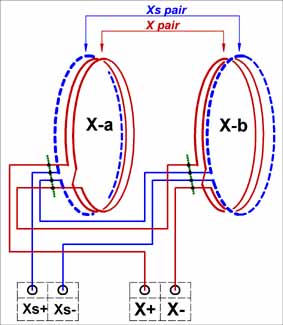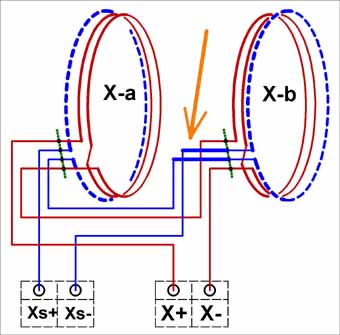|
- Helmholtz Coils -
Comments on aspects of design of the BH300/600/1300
family
In
general:
It was looked for simplicity and robustness
with the smaller weight, with the possibility of modifying the
configuration of the coils to obtain a great versatility. Serviciencia
started to produce coils with these features on 2005.
The
support:
We have devised the system of 4 pillars fixed to a
lower plate and another
upper one. The coils are fixed with special
fork brackets screwed to the
pillars.
This
system provides firmness to the set and great facility to place the
device under study at the centre of the coils, being also relatively easy its
assembly and its possible disassembly. The same support is used for the
three versions of each size (one, two or three axes).
The inferior plate also makes of table to help to place the object
under study, or the necessary instruments, in the coils (the plate has a threaded
hole at its centre). Also it serves to locate the wiring channels and the connection terminal
block for the pairs of coils.
The superior plate has a circular window to allow the passage of objects towards the
centre of the
coils. This plate can be removed if it were necessary, without harming too much
the rigidity of the set (excepting for the one axis versions). Also it can be replaced by another plate
done
specially for some application in particular.
The plates are of foamed PVC, with a density similar to the one of the
softwood, reason why they are easy to drill or to cut if it is necessary.
The
connections:
Each single coil of a pair has its own
terminal block with nuts to
hold the terminals of connection cables. This makes possible to modify the
connections in each coil as wanted and with enough easiness. An example
would be
the "anti-Helmholtz" set-up, to generate gradients instead of homogeneous
fields (see a comment in below about this applied to the forms).
The
forms (or bobbins):
We
developed specific techniques to curve "U" shaped profiles in very
precise circles and to accommodate the winding in its channel. We use
profiles of an aluminium alloy because they don't distort the magnetic
field, don't need exterior finishing coating and for being light but with a
suitable mechanical rigidity.
Under these premises we obtain coils with a cross-sectional area the smaller
as possible in practice, which results in a better access to its interior, among
other benefits.
These forms provide an optimal evacuation of the heat generated by the
electric current, which makes possible a relatively high current
density in the windings.
The concept "In-Circuit
Coils Forms":
We think that this is a feature unique to our
Helmholtz coils (1)(Footnote), put
into practise with the aim to obtain a maximum versatility of the sets.
The basic idea is to use also the aluminium forms like coils. It is a
logical consequence of the fact that each one of these circular forms must
have its ends electrically separated in order that does not behave
like a short-circuited
loop when the coil works with alternating current.
Therefore each form constitutes a coil of a single turn. We have made the connections between the two
of each pair and between these and the general
connection block.
This way we obtain an "extra" Helmholtz pair in each axis (denominated with
the suffix "s" after the letter of the axis). The following simplified
scheme shows the standard connection of pair X. For axes Y and
Z it is
applied the same.

We call Xs the pair formed by the
forms of pair X. In the same way exist Ys and
Zs. X-a and X-b are the two coils of pair X.
Applications of
"In-Circuit Coils Forms":
At the moment we conceive two basic applications:
like electrostatic screens and for generating small special fields.
Like electrostatic screens when, for example, the coils are used like sensors
of magnetic flux in the measurement of the magnetization, or the magnetic
moment, of
some magnet or another magnetized piece. A proper connection of the forms could
diminish the electrical noise remarkably when the signal is very low.
The wiring in between the two forms of a pair contributes to keep these at
same potential, what is very useful in applications at high frequencies,
because helps to diminish the generated electrical field, which is
normally unwanted due to the possible capacitive coupling with the DUT.
Noteworthy, the generated electric field increases with frequency.
But more interesting they seem, nevertheless, for field generation, for which we
suggest the following two applications.
First is the generation of a secondary homogeneous field to modulate the
main field, by means of a source of current different from the one for
the main pair.
Second it is the generation of small magnetic gradients to improve the homogeneity
of the main field when it is tried, for example, to cancel the
terrestrial magnetic field in a very high degree. This could be necessary
due to gradients in the local field produced by the influence of
neighbouring
ferromagnetic masses, such as structures of the building, machinery, terrain
features, etc.
Also it can be useful for some experiment in particular that needs a
main field with a superposed gradient, static or variable.
In order to generate a gradient with a pair of coils these must be connected
of the
way that usually is called "anti-Helmholtz". In the following figure we show the
same former Xs forms pair connected in this way.

The arrow indicates the modified connections,
drawn up in
heavier blue lines. Comparing this scheme with the previous one aids to notice better the difference "Helmholtz / anti-Helmholtz".
We trust that the users will be able to find other utilities to this
feature of our coils. We will be delighted in to know about this.
Updated:
30-Nov-2022
|